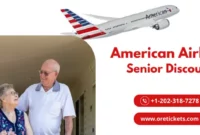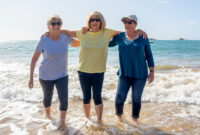Seniors Holiday Travel Club sets the stage for an exploration of curated travel experiences designed specifically for the active senior traveler. This detailed examination delves into the planning, marketing, and community-building aspects of establishing and operating a successful club catering to the unique needs and desires of this demographic. We’ll explore everything from crafting ideal itineraries and managing logistical challenges to building a strong sense of community among members.
This analysis provides a comprehensive guide, covering target audience identification, trip planning logistics, marketing strategies, membership benefits, destination selection, emergency preparedness, and community engagement. The goal is to equip prospective club founders with the tools and knowledge necessary to create a thriving and rewarding travel experience for their members.
Defining the Target Audience
Our Seniors Holiday Travel Club caters to a specific demographic with unique needs and preferences. Understanding this target audience is crucial for designing successful and fulfilling travel experiences. This section will outline the typical profile of our members, their travel motivations, and their specific concerns.
Our primary target audience comprises individuals aged 60 and above, although we welcome active and healthy individuals in their late 50s. This demographic represents a growing segment of the population with increased disposable income and a desire for enriching travel experiences.
Demographic Profile
The typical member is likely to be retired or semi-retired, possessing a moderate to high level of disposable income. They may be traveling solo, as a couple, or with a small group of friends or family. Many members value their independence and enjoy exploring new cultures and destinations at their own pace. Education levels vary, but a significant portion possess at least a high school diploma, with many holding college degrees. Health is a key consideration; while many are active and enjoy physical activities, others may have mobility limitations or require specific accommodations. Geographical location varies widely, reflecting the broad reach of our club.
Travel Motivations and Preferences
Senior travelers are motivated by a range of factors, often prioritizing relaxation and rejuvenation. Many seek culturally enriching experiences, such as visiting historical sites, museums, and attending local events. Others prefer leisurely paced itineraries with ample time for relaxation and personal exploration. Comfort and convenience are paramount; members often prefer comfortable accommodations, convenient transportation, and itineraries that minimize stress and physical exertion. They may also prioritize destinations with accessible infrastructure and readily available healthcare services. Popular destinations often include locations with mild climates, well-established tourist infrastructure, and rich cultural heritage. For example, cruises to the Mediterranean or escorted tours of European capitals are consistently popular choices.
Specific Needs and Concerns of Senior Travelers
Senior travelers have unique needs and concerns that must be addressed. These include considerations related to health and safety, accessibility, and ease of travel. Many senior travelers require accessible accommodations, including ramps, elevators, and wider doorways. Travel insurance that covers medical emergencies is a high priority, as is access to reliable healthcare services at the destination. Simple, easy-to-understand itineraries that minimize stress and confusion are preferred. Clear communication and readily available support are also essential, as is the availability of options for different levels of physical activity. For example, the option of choosing between a walking tour and a bus tour allows for varied levels of participation. Many also value opportunities for social interaction and connection with fellow travelers.
Building Community and Social Engagement
Building a strong sense of community is vital for a successful senior travel club. It fosters a welcoming atmosphere, encourages participation, and ultimately enhances the travel experience for all members. A thriving community encourages repeat bookings, referrals, and a higher level of member satisfaction. This is achieved through a multifaceted approach focusing on pre-trip, during-trip, and post-trip engagement.
Creating a welcoming and inclusive environment for members with diverse backgrounds and needs is paramount. This involves proactive measures to ensure all members feel valued and respected, regardless of their physical abilities, cultural heritage, or personal preferences. Open communication and a commitment to accessibility are key components of this strategy.
Pre-Trip Social Activities
Pre-trip activities are crucial for building camaraderie before the adventure begins. These activities help members get to know each other, share travel experiences, and build anticipation for the upcoming journey. Examples include informal online forums, virtual meet-and-greets, and themed pre-trip gatherings focusing on the destination’s culture or cuisine. A dedicated club newsletter or email chain can also facilitate communication and information sharing among members.
During-Trip Social Interactions
The trip itself presents numerous opportunities for social interaction. Structured group activities, such as guided tours, cooking classes, or themed excursions, encourage bonding. The club could also organize informal social events within the trip itinerary, like evening gatherings or optional excursions catering to different interests. Encouraging members to participate in shared activities promotes a sense of collective experience and strengthens their bonds.
Post-Trip Engagement
Post-trip activities are just as important as pre-trip and during-trip interactions. Sharing photos and memories through an online photo album or dedicated social media group keeps the sense of community alive. The club could organize a post-trip gathering to reminisce and share experiences. Feedback surveys and informal discussions can also help the club improve future trips and cater better to member preferences. This ongoing engagement reinforces the club’s value and encourages future participation.
Strategies for Fostering Community
Several strategies can be implemented to enhance the feeling of community within the club. These include: establishing a welcoming and inclusive communication channel (e.g., a dedicated forum or social media group); organizing regular social events both online and offline; celebrating members’ birthdays or anniversaries; creating opportunities for members to share their skills and talents (e.g., photography workshops, language exchange sessions); and implementing a buddy system to pair new members with experienced ones, providing support and guidance. Regular communication, acknowledging members’ contributions, and celebrating successes are crucial for building a strong and supportive community.
Closing Notes
Ultimately, the success of a Seniors Holiday Travel Club hinges on a meticulous approach to planning, a keen understanding of the target audience, and a commitment to fostering a vibrant and supportive community. By carefully considering the elements discussed – from itinerary design and risk mitigation to marketing and member engagement – club organizers can create enriching travel opportunities that cater to the specific needs and preferences of senior travelers, ensuring unforgettable and safe adventures.




